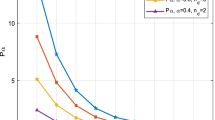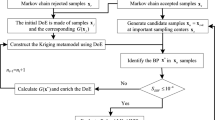Abstract
Profust reliability analysis, in which the failure state of a load-bearing structure is assumed to be fuzzy, is investigated in this paper. A novel active learning method based on the Kriging model is proposed to minimize the number of function evaluations. The new method is termed ALK-Pfst. The sign of performance function at a given random threshold determines the profust failure probability. Therefore, the expected risk function at an arbitrary threshold is derived as the learning function of ALK-Pfst. By making full use of the prediction information of Kriging model, the prediction error of profust failure probability is carefully derived into a closed-form expression. Aided by the prediction error, the accuracy of Kriging model during the learning process can be monitored in real time. As a result, the learning process can be timely terminated with little loss of accuracy. Four examples are provided to demonstrate the advantages of the proposed method.







Similar content being viewed by others
Availability of data and material
The simulation data within this submission is available based on the request.
Code availability
Implementation codes are available upon request.
Abbreviations
- RA:
-
Reliability analysis
- PDF:
-
Probability density function
- MCS:
-
Monte Carlo simulation
- IS:
-
Importance sampling
- SS:
-
Subset simulation
- ALK:
-
Active learning methods based on the Kriging
- ERF:
-
Expected risk function
- AK-MCS:
-
Active learning method combining Kriging model and MCS
- DS-AK:
-
Dual-stage adaptive Kriging
- ALK-Pfst:
-
Active learning method based on the Kriging model for the profust RA
- DoE:
-
Design of experiments
- CDF:
-
Cumulative distribution function
- WSP:
-
Wrong sign prediction
References
Du X, Chen W (2004) Sequential optimization and reliability assessment method for efficient probabilistic design. J Mech Des 126:225–233
Bichon BJ, Eldred MS, Swiler LP et al (2008) Efficient global reliability analysis for nonlinear implicit performance functions. AIAA J 46:2459–2468
Der Kiureghian A, Dakessian T (1998) Multiple design points in first and second-order reliability. Struct Saf 20:37–49
Du X (2008) Unified uncertainty analysis by the first order reliability method. J Mech Des 130:091401
Au S, Beck JL (1999) A new adaptive importance sampling scheme for reliability calculations. Struct Saf 21:135–158
Yang X, Cheng X, Wang T et al (2020) System reliability analysis with small failure probability based on active learning Kriging model and multimodal adaptive importance sampling. Struct Multidiscip Optim 62:581–596
Yang X, Liu Y, Mi C et al (2018) Active learning Kriging model combining with kernel-density-estimation-based importance sampling method for the estimation of low failure probability. J Mech Des 140:051402
Li H-S, Cao Z-J (2016) Matlab codes of subset simulation for reliability analysis and structural optimization. Struct Multidiscip Optim 54:391–410
Xiao M, Zhang J, Gao L et al (2019) An efficient Kriging-based subset simulation method for hybrid reliability analysis under random and interval variables with small failure probability. Struct Multidiscip Optim 59:2077–2092
Au S-K, Beck JL (2001) Estimation of small failure probabilities in high dimensions by subset simulation. Probab Eng Mech 16:263–277
Wang C, Matthies HG (2019) Epistemic uncertainty-based reliability analysis for engineering system with hybrid evidence and fuzzy variables. Comput Methods Appl Mech Eng 355:438–455
Pan Q, Dias D (2017) Sliced inverse regression-based sparse polynomial chaos expansions for reliability analysis in high dimensions. Reliab Eng Syst Saf 167:484–493
Papadopoulos V, Giovanis DG, Lagaros ND et al (2012) Accelerated subset simulation with neural networks for reliability analysis. Comput Methods Appl Mech Eng 223:70–80
Dai H, Xue G, Wang W (2014) An adaptive wavelet frame neural network method for efficient reliability analysis. Comput Aid Civ Infrastruct Eng 29:801–814
Fei C-W, Lu C, Liem RP (2019) Decomposed-coordinated surrogate modeling strategy for compound function approximation in a turbine-blisk reliability evaluation. Aerosp Sci Technol 95:105466
Yang X, Wang T, Li J et al (2020) Bounds approximation of limit-state surface based on active learning Kriging model with truncated candidate region for random-interval hybrid reliability analysis. Int J Numer Meth Eng 121:1345–1366
Qian J, Yi J, Cheng Y et al (2020) A sequential constraints updating approach for Kriging surrogate model-assisted engineering optimization design problem. Eng Comput 36:993–1009
Echard B, Gayton N, Lemaire M (2011) AK-MCS: an active learning reliability method combining Kriging and Monte Carlo simulation. Struct Saf 33:145–154
Wang Z, Shafieezadeh A (2019) REAK: reliability analysis through error rate-based adaptive kriging. Reliab Eng Syst Saf 182:33–45
Zhang J, Xiao M, Gao L (2020) A new local update-based method for reliability-based design optimization. Eng Comput
Yang X, Liu Y, Gao Y et al (2015) An active learning Kriging model for hybrid reliability analysis with both random and interval variables. Struct Multidiscip Optim 51:1003–1016
Wang J, Sun Z, Yang Q et al (2017) Two accuracy measures of the Kriging model for structural reliability analysis. Reliab Eng Syst Saf 167:494–505
Wang Z, Shafieezadeh A (2020) On confidence intervals for failure probability estimates in Kriging-based reliability analysis. Reliabil Eng Syst Saf 196:106758
Zhang J, Xiao M, Gao L (2019) An active learning reliability method combining Kriging constructed with exploration and exploitation of failure region and subset simulation. Reliab Eng Syst Saf 188:90–102
Yang X, Mi C, Deng D et al (2019) A system reliability analysis method combining active learning Kriging model with adaptive size of candidate points. Struct Multidiscip Optim 60:137–150
Lelièvre N, Beaurepaire P, Mattrand C et al (2018) AK-MCSi: A Kriging-based method to deal with small failure probabilities and time-consuming models. Struct Saf 73:1–11
Hu Z, Mahadevan S (2016) Global sensitivity analysis-enhanced surrogate (GSAS) modeling for reliability analysis. Struct Multidiscip Optim 53:501–521
Haeri A, Fadaee MJ (2016) Efficient reliability analysis of laminated composites using advanced Kriging surrogate model. Compos Struct 149:26–32
Cai K-Y, Wen C-Y, Zhang M-L (1993) Fuzzy states as a basis for a theory of fuzzy reliability. Microelectron Reliab 33:2253–2263
Feng K, Lu Z, Yun W (2019) Aircraft icing severity analysis considering three uncertainty types. AIAA J 57:1514–1522
Zhang X, Lu Z, Feng K et al (2019) Reliability sensitivity based on profust model: an application to aircraft icing analysis. AIAA J 57:5390–5402
Wu FF, Zhang ZF, Mao SX (2009) Size-dependent shear fracture and global tensile plasticity of metallic glasses. Acta Mater 57:257–266
Jiang Q, Chen C-H (2003) A numerical algorithm of fuzzy reliability. Reliab Eng Syst Saf 80:299–307
Pandey D, Tyagi SK (2007) Profust reliability of a gracefully degradable system. Fuzzy Sets Syst 158:794–803
Feng K, Lu Z, Pang C et al (2018) Efficient numerical algorithm of profust reliability analysis: an application to wing box structure. Aerosp Sci Technol 80:203–211
Zhang J, Xiao M, Gao L et al (2018) A novel projection outline based active learning method and its combination with Kriging metamodel for hybrid reliability analysis with random and interval variables. Comput Methods Appl Mech Eng 341:32–52
Wei P, Song J, Bi S et al (2019) Non-intrusive stochastic analysis with parameterized imprecise probability models: II. Reliability and rare events analysis. Mech Syst Signal Process 126:227–247
Jahani E, Muhanna RL, Shayanfar MA et al (2014) Reliability assessment with fuzzy random variables using interval Monte Carlo simulation. Comput Aid Civ Infrastruct Eng 29:208–220
Wang C, Matthies HG (2021) Coupled fuzzy-interval model and method for structural response analysis with non-probabilistic hybrid uncertainties. Fuzzy Sets Syst 417:171–189
Wang C, Qiu Z, Xu M et al (2017) Novel reliability-based optimization method for thermal structure with hybrid random, interval and fuzzy parameters. Appl Math Model 47:573–586
Bing L, Meilin Z, Kai X (2000) A practical engineering method for fuzzy reliability analysis of mechanical structures. Reliab Eng Syst Saf 67:311–315
Zhang X, Lyu Z, Feng K et al (2019) An efficient algorithm for calculating Profust failure probability. Chin J Aeronaut 32:1657–1666
Ling C, Lu Z, Sun B et al (2020) An efficient method combining active learning Kriging and Monte Carlo simulation for profust failure probability. Fuzzy Sets Syst 387:89–107
Dubourg V, Sudret B, Deheeger F (2013) Metamodel-based importance sampling for structural reliability analysis. Probab Eng Mech 33:47–57
Razaaly N, Congedo PM (2018) Novel algorithm using active metamodel learning and importance sampling: application to multiple failure regions of low probability. J Comput Phys 368:92–114
Feng K, Lu Z, Wang L (2020) A novel dual-stage adaptive Kriging method for profust reliability analysis. J Comput Phys 419:109701
Ling C, Lu Z, Zhang X et al (2020) Safety analysis for the posfust reliability model under possibilistic input and fuzzy state. Aerosp Sci Technol 99:105739
Zhao Z, Quan Q, Cai K (2014) A Profust reliability based approach to prognostics and health management. IEEE Trans Reliab 63:26–41
Yang X, Cheng X (2020) Active learning method combining Kriging model and multimodal-optimization-based importance sampling for the estimation of small failure probability. Int J Numer Meth Eng 121:4843–4864
Johnson O (2004) Information theory and the central limit theorem. World Scientific, Singapore
Dong H, Nakayama MK (2020) A tutorial on quantile estimation via Monte Carlo. Springer, Cham, pp 3–30
Wassily H, Robbins H (1948) The central limit theorem for dependent random variables. Duke Math J 15:773–780
Yang X, Liu Y, Fang X et al (2018) Estimation of low failure probability based on active learning Kriging model with a concentric ring approaching strategy. Struct Multidiscip Optim 58:1175–1186
Mao H, Mahadevan S (2000) Reliability analysis of creep–fatigue failure. Int J Fatigue 22:789–797
Bouhlel MA, Bartoli N, Otsmane A et al (2016) Improving kriging surrogates of high-dimensional design models by Partial Least Squares dimension reduction. Struct Multidiscip Optim 53:935–952
Acknowledgements
This work is supported by the National Natural Science Foundation of China (Grant no. 51705433), the Fundamental Research Funds for the Central Universities (Grant no. 2682017CX028).
Author information
Authors and Affiliations
Corresponding author
Ethics declarations
Conflict of interest
The authors declare that they have no conflicts of interest.
Rights and permissions
About this article
Cite this article
Yang, X., Cheng, X., Liu, Z. et al. A novel active learning method for profust reliability analysis based on the Kriging model. Engineering with Computers 38 (Suppl 4), 3111–3124 (2022). https://doi.org/10.1007/s00366-021-01447-y
Received:
Accepted:
Published:
Issue Date:
DOI: https://doi.org/10.1007/s00366-021-01447-y




